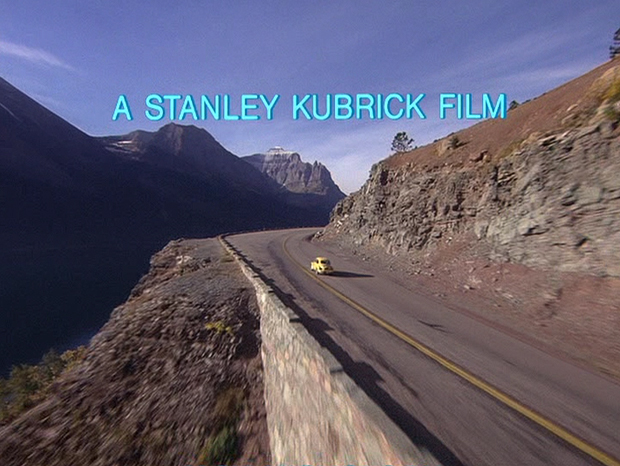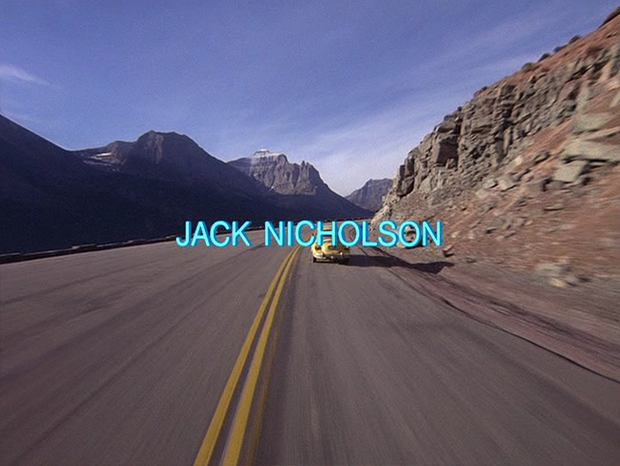DOES THE OPENING OF THE SHINING

Go to Table of Contents of the analysis (which has also a statement on purpose and manner of analysis and a disclaimer as to caveat emptor and my knowing anything authoritatively, which I do not, but I do try to not know earnestly, with some discretion, and considerable thought).
The 2015 restoration of L'Inhumaine was available on Mubi recently, a 1924 silent by Marcel L'Herbier. As I watched I'd realized, oh, yeah, I'd possibly seen a short bit of this previously. Where? I've no idea. Had I seen it in college, many years ago, and had long since lost any recollection of it? Perhaps I'd been directed to a clip up on Youtube. Maybe I'd seen screengrabs from the film in a book or online. But it seemed to me I recognized the exterior of the house of the character, Claire, and thought the film would be interesting for the design elements if nothing else. I shortly found myself glued to the screen. Plus the music by Aidje Tafial, used with this latest restoration, is phenomenal.
Then Kubrick entered the film--or seemed to--and I was quite taken aback at unexpectedly watching a portion of The Shining in a 1924 silent. I wish there was a clip of the scene of L'Inhumaine, on Youtube, which threw me into The Shining but there's not, which is a shame as it's going to be nearly impossible to aptly describe how entwined I felt the very first of the opening credits section of The Shining was with the "suicide" scene of the character Einar Norsen in L'Inhumaine, and I use quotation marks around suicide for a reason.
I suppose I was also surprised by this because in L'Inhumaine the "suicide" scene doesn't happen until we're well into the film and have had an opportunity to become acquainted with the character of Jaque Catelain as Einar Norsen, who was about 26 when L'Inhumaine was made and looks surprisingly like he could be a youthful Philip Stone, the actor who played the waiter in The Shining.
How to describe L'Inhumaine, because the plot is absurd and plays absurdly, and the acting doesn't at first appear to be its strong point, especially in the case of Georgette Leblanc, an opera diva who appeared in a number of plays, and plays the lead, a singer, in the movie. L'Inhumaine, filmed when she was about 53, and which she financed, was her only movie. Her connection to the camera reads at first as both extravagant and vacuous, we are often unable to tell how she feels, as if her expression is disconnected from context, her mouth and her eyes working independently of what they might intend to communicate, and her mouth sometimes giving a read of several different expressions. Her chemistry with the other actors can appear to be virtually non-existent, which hardly matters as only one other character has any real significance. That is Einar, who Catelain plays in a curiously restrained, enigmatic manner, yet is also a current of electric, youthful excitement throughout, and manages to make us believe that he is fixated upon Claire, though the film does its best to offer no plausible reason why. Perhaps it was all in my mind, influenced by my feeling he resembled Stone, but his style reminded of the physically restrained roles in which Kubrick cast Stone. Embarrassingly timid (in a slimy, stiff way) in A Clockwork Orange, as the waiter in The Shining his wooden subservience took a subtle turn into boiling waters of hell malevolence. The role of Einar is nothing like these two Stone characters, but there is a shared reserve and the fine hairs employed as articulators.
I said "at first" Georgette's acting seems stiff and not to work. But the point is that she is the inhuman woman. The ambiguity of her expressions is a part of this.
L'Inhumaine shouldn't work. You have to intellectually disengage from the plot as the plot is ridiculous, and there's nothing in the film to catch you up in a sentimental swell of emotion so that can't be the reason for one's captivation. Yet one is intellectually involved, analyzing what is going on, wondering how in the world this is working on you when you realize that it is, and emotionally involved as well as it can be breathtaking and you want to understand why and see what happens next all the way to the end, even while you're thinking, "Wow, this plot is awful. Why and how is this working?" There's some striking cubist design in the film, but that's not why it works, and there are also times when the cubist design elements instead clunk to the floor with a resounding thud. And yet one is entranced, like it's magic. Jaque's radiating his own dimension, Georgette's radiating hers, and he and Georgette end up making their own little world that at first seemingly has nothing to do with each other and everything to do with the feeling you're watching her as a figment of her imagination, and them both as a figment of his. But somewhere along the way you are also made a part of that world and it is startlingly affecting.
The story. A singer surrounds herself with suitors at a party where the servants wear identical masks that are said to keep them from hearing all that transpires and their mouths fixed in perpetual grins. When Einar arrives, late, he learns Claire will be announcing her engagement to one of the other suitors who has offered her a vision of life and future she finds most exciting. Love has nothing to do with it. What Claire announces to her suitors is that she will be taking a solitary trip around the world, which provokes them all to intense jealousy. A "humanitarian" attempts to get her interested in him and the life he could offer her, but she says she's not interested in humanity, only the most interesting people. A newspaper reports that she will be marrying a maharaja, but when he gives her a vision of his placing a "wreath" (a crown) on her head as the reason for why she should choose him, she says she's not yet dead, "kill me first".
Einar? Well, desperate Einar exclaims he needs her strength (force) for himself alone. Otherwise? He will kill himself!

Claire, who is "inhumane", scoffs and mocks Einar. She says if he was so willing to do so than his life was without meaning anyway. Then she has one of her servants deliver to him, concealed in a handkerchief, a small stiletto that is perfect for elegantly stabbing yourself in the jugular.
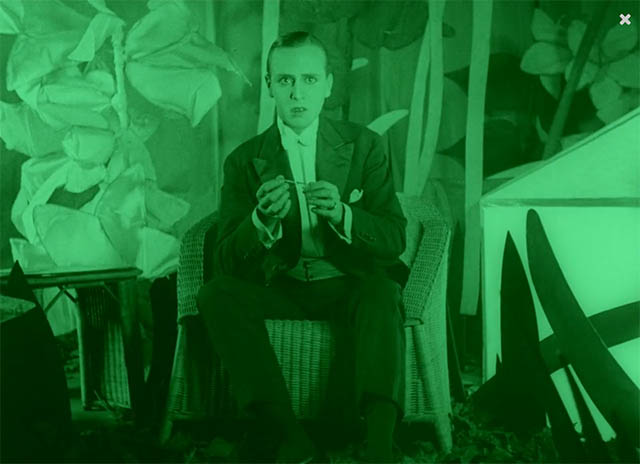
Ouch! Stricken, Einar flees from the party in his racing car. A wild drive ensues in which the film cuts between Einar in his car and Claire singing at the party.
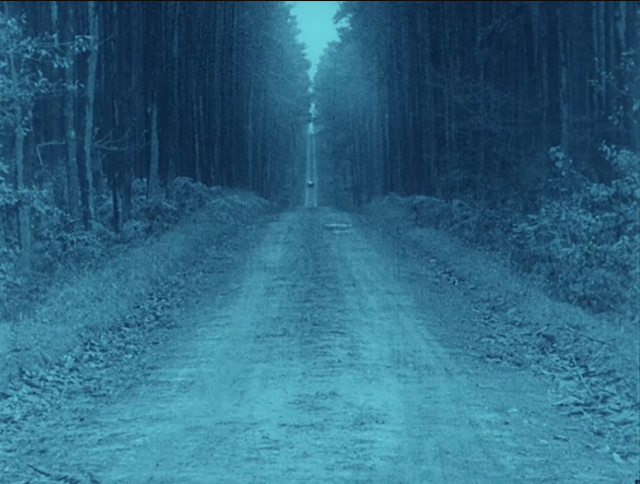
How single point perspective Kubrick can you get without it being Kubrick. The moment I saw the above shot, I thought, "Kubrick's vanishing point in The Shining's opening, when the car hugs the mountain and the camera zooms over the side of the mountain into the vanishing point, into open air. Einar's drive through the forest doesn't look like the drive up the mountain in The Shining, but it's here." And I also thought, "Eyes Wide Shut, it seems to be here as well, the drive through the evergreens to the Somerton underworld."
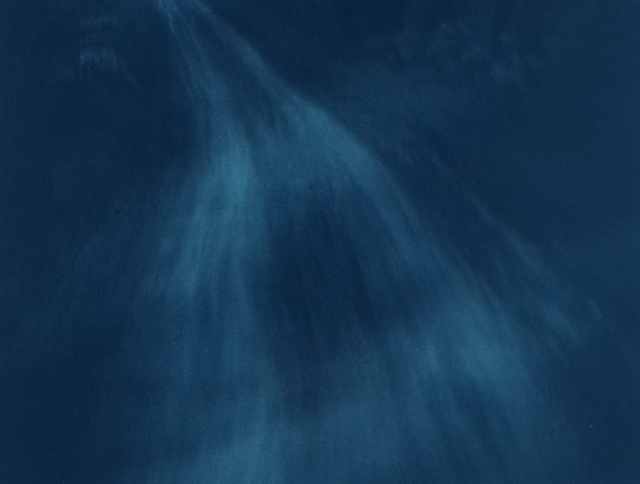
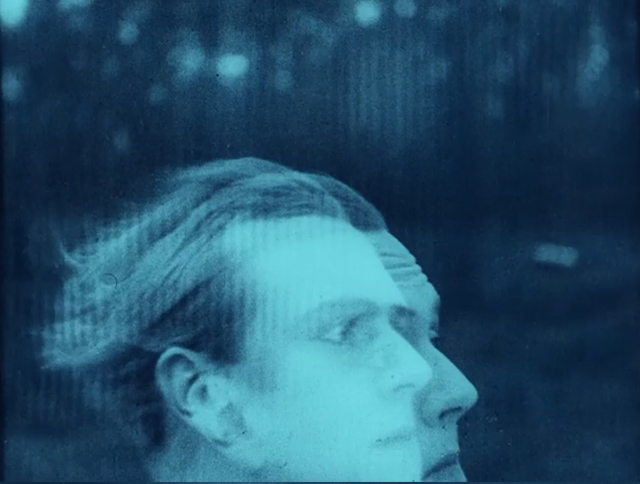

Seeing the above, I was amazed that it was the drive to Somerton after all, the crossfade of the trees on Bill's face as the taxi approaches the mansion's gate the same as the trees layered over Einar's face.
Einar leaves the forest, the road now hugging mountain, a steep drop off to a river on the other side.
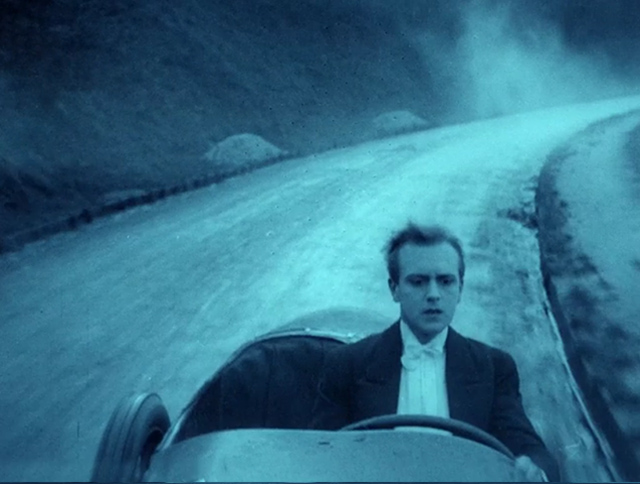
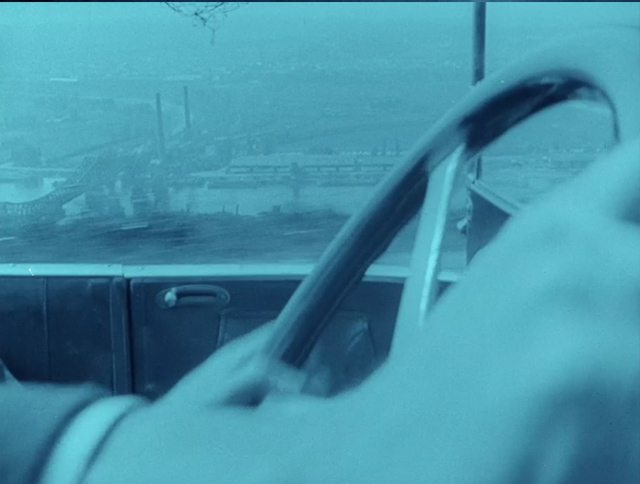
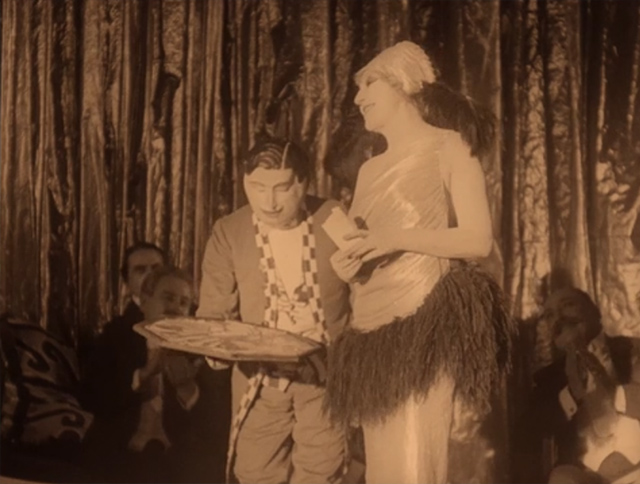
Claire, while still singing, is delivered a message by a servant.

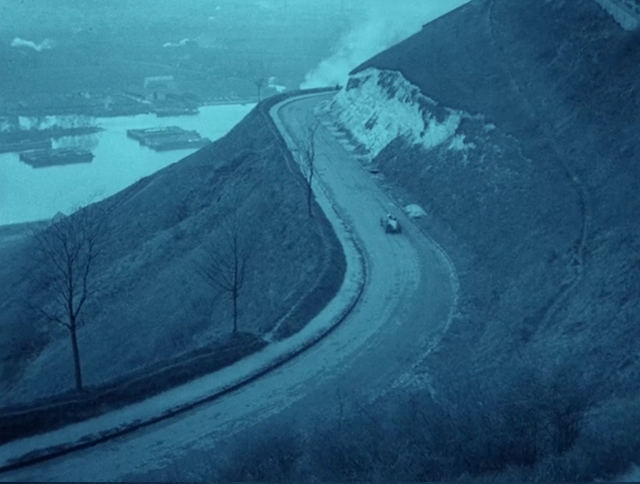
So, it is The Shining after all! By now, I was on the edge of my seat, agog.

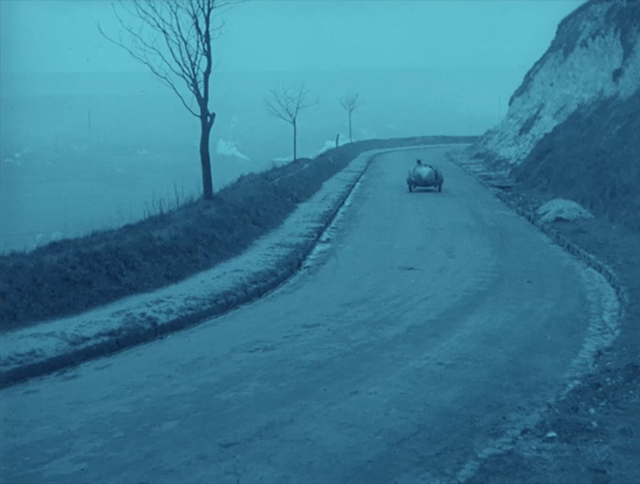
You know, right then, Einar's race car is going to go flying nto the vanishing point horizon, straight over the cliff, just as the helicopter separates from the yellow VW in The Shining to soar bird-like out over the mountainside leaving the VW behind.
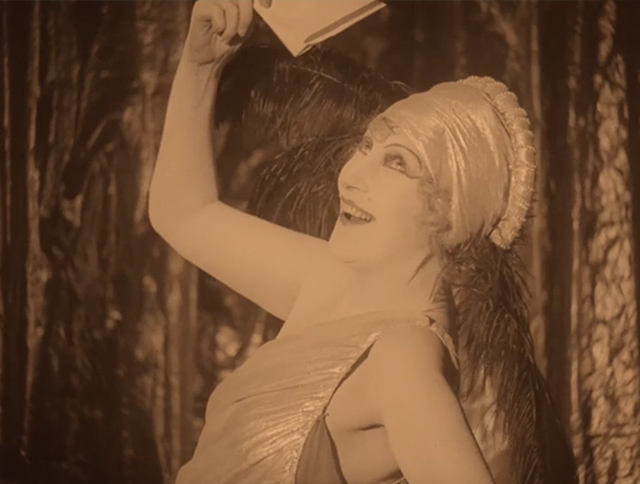


And there you go. You don't see Einar in the car as it topples over, but you assume we're supposed to believe he's already fallen out and bounced down the mountainside into the river. Back at the party. Claire's song ends as the car crashes. Which makes it a death song. Now she finally reads the message.

Oh, no! It's from Einar. Einar! Where is Einar? Has he left the party!?
A young peasant woman who had observed Einar's car enter the road from Claire's, who had followed his car at a great distance and come upon the site of the crash, rushes back to Claire's to deliver the news. Everyone believes Einar has committed suicide. Tragic.
In the below video, we have two views of the road for L'Herbiert that show us Einar in his car rushing to the party at Claire's. (Or this used to be up at Youtube. I'm leaving it as a place holder possible later addition.).
The first time we are not shown the critical bend in the road over which the car plunges. In The Shining we have the helicopter soaring off, then Jack, unobserved, continuing his drive up to the hotel for the interview. Then there is the drive up with his family on closing day, in which they are actually moving in an opposing direction on the Going to the Sun Road, the drop into the valley always on the right of the car rather than the left.
After Einar's supposed suicide, talk turns the next day against Claire, for her being so inhumane, responsible for Einar's death. She wonders how can she perform that night in public? Should she? She decides she must, for art, and does perform and wins back everyone's hearts with her beautiful singing. Meanwhile, we've observed a suspicious looking fellow watching her perform at the opera house. Though he is disguised in a mustache, we know it is Einar. After the performance, overcome by all that has transpired, Claire refuses to see the mahuraja suitor, who becomes jealous when he lurks and observes her with this mysterious gentleman, who tells Claire that Einar's body has been found and she must come and identify it the next day. She consents.
The following day she is taken to Einar's house by the disguised man she hasn't recognized as Einar. He leaves and she enters a room in which Einar's body appears to be laid out under a sheet. Murkety murk takes place with her apparently having realized she loves Einar alone. We don't know because the title cards say only that she reveals the secret of her suffering ("elle laisse enfin percer le secret de son immense douleur humaine"), but it doesn't say what that secret is and we're not told what she's saying to the dead Einar covered with a sheet. Einar then appears in the flesh (what an abusive asshole, I'm thinking, get the hell away from that guy) to tell Claire he had thought about committing suicide, had planned to do it, but had instead pushed his car over the cliff and let everyone think he was dead "in order to discover what you kept hidden".
He shows her into his magical science laboratory.

"Wait. That doesn't have anything to do with futuristic movie style science," I think. "It instead looks like it has everything to do with the art of cinema."
Claire returns the following day and Einar shows her a device he has built for her. She will be able to sing and have her voice communicated all over the world, but instead of others being able to see her perform, she will be able to observe her audience listening to her. She sings and the clock spins time quickly by, so caught up is she in watching the response of her listeners world-wide, in their homes, their cars, no matter where they are she is able to view them.
She feels their pain and their joys.
As Claire leaves to go to the theater to perform again that night, Einar shows her another invention that should have the capacity to restore life, but it's as yet unproven for he's not had the opportunity to test it. He has already, previously, directed her away from a dangerous machine that promises death if you touch it. He asks Claire if she will return that night, and she promises that she will. We are unable to tell if she loves Einar or his machines, but Einar doesn't seem to care so why should we.
When Claire is done performing, the jealous mahuraja disguises himself as her chauffeur and takes seriously her earlier statement that he should kill her first before she wears the wreath, for he plants a poisonous snake in some flowers into which he also inserts a gift card from Einar. In the car, on the drive back to Einar's, Claire is bitten by the snake, it drawing blood from her wrist, and is unconscious by the time the jealous suitor delivers her to Einar's home.
Remember that road with its curves that winds the mountain to Einar's? It is serpentine, and the serpent biting Claire on the same road returns us to his faked suicide and the car being pitched off it. Einar's drive had been filled with the emotion of Claire's denial of him, she having given him a small stiletto of the right size for stabbing a vein. The snake that bites her draws blood from the inside of her wrist which visually reminds of the cutting of a wrist vein. As we can see below, the mysterious machine that is labeled "danger de mort" also is decorated with a serpentine design--it is as the road as well. The spurned and jealous mahuraja who masquerades as chauffeur for Claire and places the poisonous snake in the flowers in the back seat next to her, while at the party at Claire's wore a turban of cloth with a repeated diamond motif that resembles snake skin.

Einar carries her inside his laboratory and and on his second attempt, the first failing, brings her back to life with his machine that does inexplicable things nowhere near her body. No wires hooked up to her. No Frankenstein's monster apparatus. Healing magic must be radiating through the ozone. Very New Wave Metropolis with jumpsuits. Resuscitated, Claire opens her eyes and says something to the effect that she had returned that night for the dangerous experience. It was out of love for...humanity. And this seems to be exactly what Einar was waiting to hear, wanting to hear all along.
This is not your typical love story. Instead, the love that Einar desired for Claire was something greater. Claire has been transformed into a humane, compassionate individual and is no longer a femme fatale monster.
I read that the plot originally had its inspiration in the story of a man who took advantage of a "false report of his death in order to adopt a new identity", which ultimately became L'Herbier's 1925 Feu Mathias Pascal. And there seems a certain resonance between that and The Shining, especially the original ending in which Ullman visits Wendy in the hospital and tells her they've found nothing to confirm her tale of horror. There is no evidence. What this means is exceedingly vague in the few pages of script that have survived. One must assume that Dick's body is gone. Has Jack, too, disappeared? Well, that's what we know of that ending from the surviving script. And even with that having been cut out of The Shining, in the final scene of the photo we have Jack preserved in a 1921 photo of the Overlook.
L'Inhumaine actually has not one but two reanimation scenes. For first Einar is resurrected from his supposed death and displays to Claire the mannequin that she had supposed was his dead body. The second reanimation is Claire's.
Fernand Leger, the cubist artist, did part of the design for L'Inhumaine. Rather than rephrase, below is a portion from my analysis on Killer's Kiss:
His wife at the time of Killer's Kiss, the ballet dancer in it was Ruth Sobotka, and in 1947 she had been in the surrealist film, Dreams that Money can Buy, specifically the Man Ray portion, "Ruth, Roses and Revolvers", in which theater-goers are encouraged to replicate what is happening on the movie screen. But the short preceding this was Fernand Leger's, "The Girl with the Prefabricated Heart", was all mannequins, with lyrics concerning today's goddess being formed on the assembly line. Her heart, as well, is prefabricated. The gods send her a mail-order, perfect mannequin man, each made for each other. He loves her truly and they become engaged. Married, the prospect of physical love for the mannequin frightens her, it making a muss of her hair and clothes. Fearing emotions, she flees. Thus she remains pure, while the groom, abandoned, crying, disintegrates.
The mannequin as an inhuman woman?
As Kubrick's wife had acted in this film in which Fernand Leger was also involved, it's not unreasonable to assume Kubrick may have been familiar with L'Inhumaine.
Mannequins played significantly in Killer's Kiss, in which Gloria said she had accused her sister, Iris, of being like a stone, neither loving their father nor her husband--the why for that need not concern us here. Iris, played by Ruth Sobotka, would have been then viewed by Gloria as inhuman.
My supposition is that at the opening of The Shining Kubrick was referring to the suicide scene in L'Inhumaine but of course I could be wrong.
When we consider the wreath, which Claire refuses as she's not dead yet, we may even have a reference to L'Inhumaine at the end of The Shining with the wreathed woman standing behind Jack.
But, if he was referring to L'Inhumaine, why?
When Einar appears to go over the cliff the film effectively splits into two stories, what is believed to have happened and what has happened. And so it's interesting that at the place of that split, we have a split with Kubrick as well, the helicopter/camera leaving the VW to soar out over the cliff as the little yellow VW goes round a curve, keeping to the road. We have a split reality in The Shining with Jack expressed as having experiences of which he seems also entirely unconscious. There is, in a sense, more than one Overlook, and I believe that may be expressed in the lobby at the beginning when we see it has both radiant heat as well as forced air. We may see a hint of this split or dual story at the end of the credits when we observe two yellow VWs in the parking lot.
Stephen King, in his book, has Danny shining, when at the doctor's, "This inhuman place, it makes monsters."
If L'Inhumaine (The Inhuman Woman) is referred to in the opening credits, are we expected to make an association with the ghastly resurrection scene in Room 237, the old woman rising out of the bathtub in several different scenarios, pursuing Jack and terrorizing also Dick and Danny as they shine her?
We've a version of the same in Eyes Wide Shut, when Bill is called to Victor's bathroom to check Mandy who has overdosed. But I'm not going to get into the difficult plot points for Eyes Wide Shut right now.
Cubism dominates the design in L'Inhumaine. There is no cubism in The Shining, unless, one might interpret the wild, geometric carpets that dominate the refurbished areas as cubist influenced. Their repeating geometric designs, especially the rug outside Room 237, might bring to mind this floor at Claire's house.
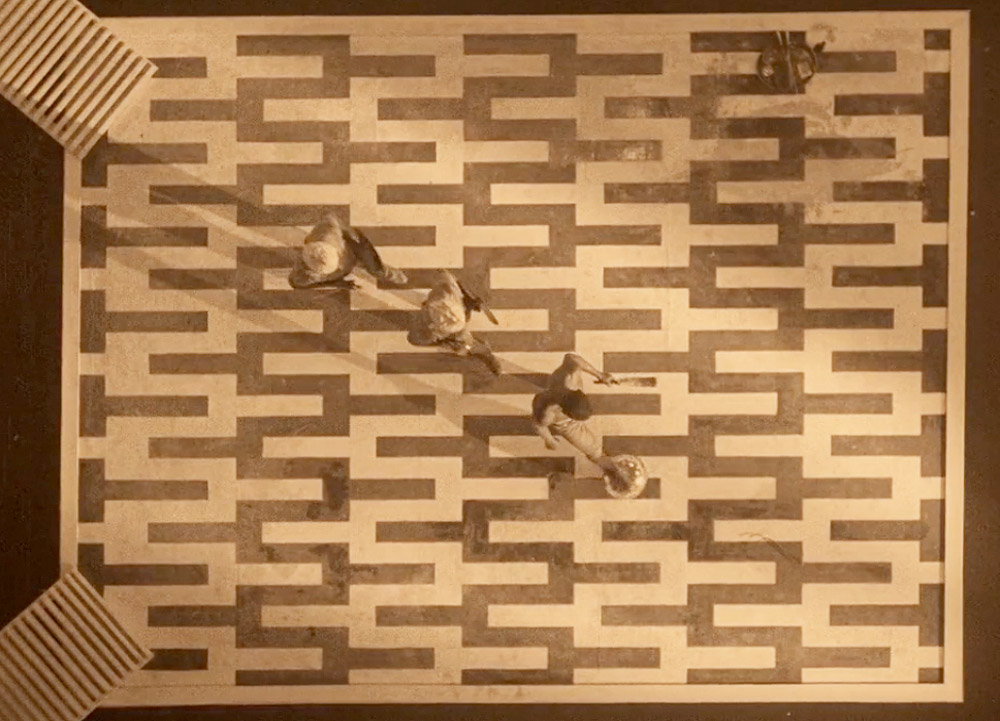
Claire's floor, when not viewed from above, briefly gives the impression of a chess board, then we realize it is not. From above, The light pattern battles with the dark, our eye continually on the move, forwards and backwards, as it can't decide where to rest. The dark and light patterns push against one another.
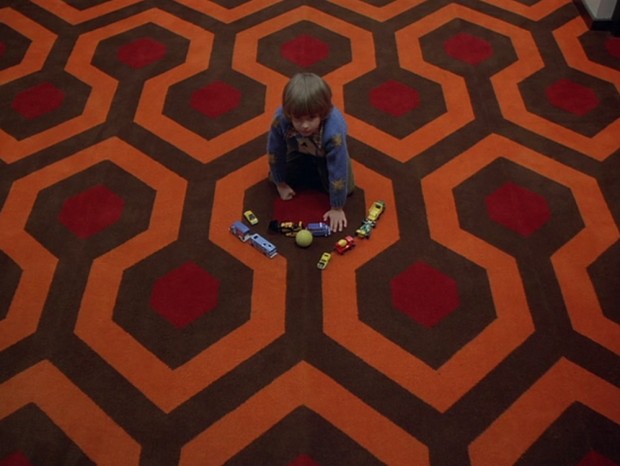
We've the same struggle for dominance in the rug on the floor of the hall outside Room 237, which way should the eye move, forward or backward, and which part of the pattern should be dominant. The eye can't determine and settle.
The presence of a ball figures strongly with both floors. It's difficult to see, but being pushed across the floor in the L'Inhumaine screengrab is a ball lined with little golden tiles. This ball is ever present on the floor throughout a variety of entertainments, sometimes held up between the performers and the camera by the servants in their masks.
In The Shining we instead have the yellow ball that Jack had earlier lost and is later rolled to Danny by an unseen hand, which causes him to go to room 237.
Thought I might as well throw this in as well. Danny's toy model cars?
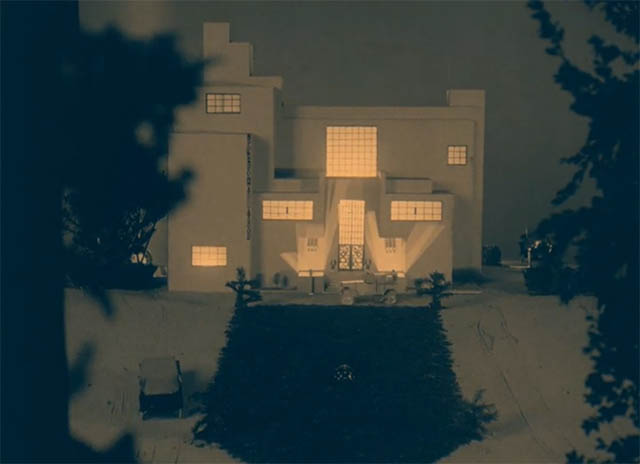
Claire's house is introduced with an obvious miniature model, which is one thing, but it is intentionally undisguised as such, with toy model cars driving up to it. After the above shot, there is a closer view of the front with the toy model cars, and then a switch is made to the set-exterior of the house with real cars pulling up. We are prepared for a fantasy.
Leger's laboratory is as a painting in L'Inhumaine, which becomes animated, brought to life, most notably during the scene in which Claire is resurrected. If we frame it and add a touch of color we get a good feeling for just how painterly it is, not only stage-set theatrical.

There's a good deal of art in Eyes Wide Shut. I don't know if it's meaningful that there are only two instances (other than some masks at Somerton) of art that might be interpreted as cubist or cubist inspired. The first is the art in the elevator to Bill's office in shot 58. I guess it may be interpreted as a cubist painting in shot 58...
...then in the same shot we immediately after have the S curve of the reception desk ending in a small fake evergreen...
... that returns us to the road leading up to the Overlook by which we will eventually confront the "suicide" scene from L'Inhumaine in The Shining.
As I've previously stated, as the helicopter soars away from the VW at that point where in L'Inhumaine the car appears to go over the cliff, we can have the film being expressed as splitting into two stories. As Bill continues into the waiting room, going to his office, we see the seating has also the same S curve that ends in a large evergreen Christmas tree.
After Bill sees Mandy at the morgue, we then observe another striking piece of art, a 3 panel screen, that could be said to have cubist elements.
A figure in what resembles a harlequin-style costume appears to be moving urgently toward the left, hand out-stretched. In the lower right is a form that resembles a head with white S waves in the eye area. If we step back up to the screengrab of Bill at the reception desk in the office we see the 1/2 black and 1/2 white diamond forms mimicked in a shopping bag beside the desk of one of the women. Elements in the film find their way into the painting which reframes them and creates a new expression.
The same frenetic energy in the art painted on the screen is depicted in L'Inhumaine as Einar and his assistants work to bring Claire back to life. We also see the same broken C. Beyond it, in L'Inhumaine, is the machine that reanimates the heart.

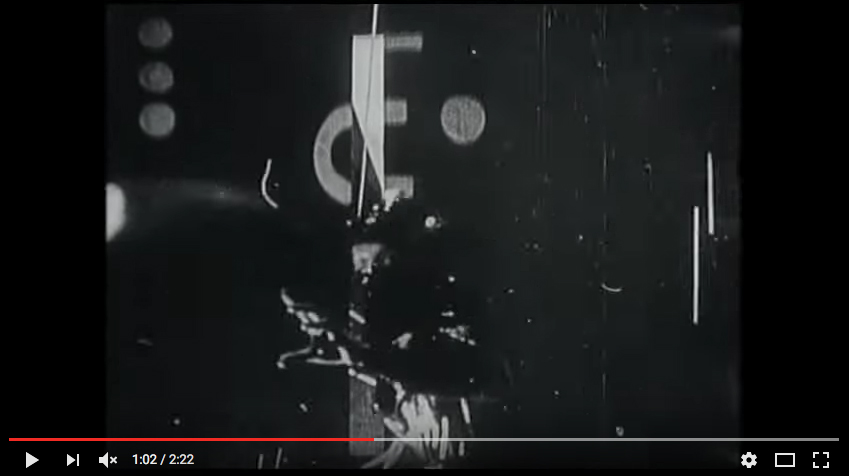


Whatever the 3-paneled painting in Eyes Wide Shut signifies, the woman in the morgue is a little like Schrodinger's Cat. Bill knows her name from the news article, Amanda. He thinks she is the woman who was at Somerton, who took his place so that he would be released, but she was masked and he never saw her face. Though he examined the face of the woman at the morgue closely, he has seemingly failed to recognize her as the woman who had overdosed at Victor's. Amanda Curran is dead. But Mandy? For the moment, Mandy is still the cat in Scrodinger's box. She's half alive, half dead. She could be either. We won't know until the box is opened and Victor tells Bill who she was.
However, the way Kubrick manages the incidents at Somerton, and an actress rather than the one who played Mandy assuming the part of the woman at Somerton who offers herself in place of Bill, the audience never is able to tell exactly what happened and who was who. The question remains open. Just as the questions concerning Jack at the end of The Shining remain open. These aren't stories with conventional solutions.
Georgette Leblanc and Gurdjieff
The idea of awakening to a higher consciousness, pinocchio becoming a real boy, is not a new story. The idea of humans as machines, who must wake to a higher consciousness, that is not new. But Georgette Leblanc's performance in L'Inhumaine as the inhuman woman who is reanimated into a being of higher consciousness possibly takes on a new hue when one learns that she was a devotee of Gurdjieff.
Wikipedia has this paragraphs on Gurdjieff which give a fundamental view on his teachings.
Gurdjieff taught that most humans do not possess a unified mind-body consciousness and thus live their lives in a state of hypnotic "waking sleep", but that it is possible to transcend to a higher state of consciousness and achieve full human potential. Gurdjieff described a method attempting to do so, calling the discipline "The Work" (connoting "work on oneself") or "the Method".
Source
Dates vary on when Georgette met Gurdjieff. Some say 1924, some say 1923.
[Jane] Heap met G. I. Gurdjieff during his 1924 visit to New York, and was so impressed with his philosophy that she set up a Gurdjieff study group at her apartment in Greenwich Village. In 1925, she moved to Paris, to study at Gurdjieff's Institute for the Harmonious Development of Man, where Margaret Anderson had moved the previous year alongside her new lover, soprano Georgette Leblanc.
Source
M. Tamdgidi's Gurdjieff and Hypnosis: A Hermenutic Study gives Leblanc knowing Gurdjieff by 1923.
Gurdjieff should have been forgotten by now, or perhaps recalled only in occasional footnotes such as the following typical gossip about him, recorded in the joint 1920s memoir of Robert McAlmon and Kay Boyle--two expatriate American writers in Paris when Eliot, Hemingway, Joyce, Mansfield, Pound, Williams, and a host of major English-language authors frequented cafe tables. Boyle recounts that one afternoon in 1923 at the Cafe de la Paix, while Gurdjieff sat at an adjacent table, she, McAlmon, and their host Harold Loeb heard an anonymous young American (who had visited a friend at Gurdjieff's Institute at the Prieure) say:
"[Gurdjieff's] cult has been spreading among people I thought were more or less sensible...Jane Heap, Margaret Anderson and Georgette Leblanc got involved...(I [Kay Boyle] remembered then that it was there that Katherine Mansfield died.) It's a mass hypnotism of some kind. Gurdjieff started years back in the East as a hypnotist...In their state of half starvation and overwork, they don't care to think or feel on their own. They live on their hallucinations."
Pierre Cumarchais and Georgette Leblanc have writing credit for The Inhuman Woman, along with Marcel L'Herbier who is given as providing the scenario. Wikipedia states that Leblanc had approached L'Herbier in 1923 with the idea of doing the film. The scenario was an old one of his titled La Femme de glace, which was too "abstract for her liking and for American taste", so Pierre revised it "according to Leblanc's suggestions, and in its new form it became L'Inhumaine." She provided 50% of the costs and would distribute and promote the film in the United States. Production began in September 1923 and was hurried as Leblanc was due in New York in October for a concert tour. It seems that shooting finished in the spring of 1924. The film proved to be a financial disaster.
I've come across nothing suggesting that Gurdjieff had any influence on L'Inhumaine in respect of Leblanc and her contributions to it--and yet the timing seems right (only if she knew Gurdjieff by 1923) for just such an influence. A redemption or soul-awakening story is not new, but what did strike me as exceptional was the choice of wording during the film which never really exposed Claire's "secret", and the film giving the impression as being a love story yet it was instead a distinctly spiritual love story, no kiss even being shared at the end. Georgette was bi-sexual and Margaret Anderson had become a couple already, but acting is acting and Georgette would not have shied from a kiss had this been a simple love story, but it's not. The age difference would have not been a problem as at one point in the film we are shown a kiss shared between another younger man with an older lover. When Claire says she is going on her world trip unless something--quelque chose--detains her, Einar deliberates then on what that quelque chose could be, picturing success and love, but appears to rule these out. But not, perhaps, the unexpected.
In her book, La Machine à Courage, Lablanc gives her initial experience of living at Gurdjieff's Prieuré in 1924 as negative. She left but decided to return, and was there for two years. Later, she was part of a Gurdjieff group for women called "the Rope" from 1935 to about 1939.
Again, in L'Inhumaine, Einar deliberates on what that something, that "quelque chose" could be that would keep Claire in Paris.
Leblanc writes in her memoire:
It was in New York in 1924 that I met someone and something. I began to think, "There is a truth here."
...
Someone and something.
And so, in New York in 1924, I met someone and something.
I was asked: "Is he the man Katherine Mansfield knew?" I answered, seemingly yes, but in reality no. She understood him 'religiously'--I am tempted to say 'ordinarily.' He was misunderstood by her, her husband and her friends. The greater a man is, the less likely one is to see the whole of him. If I succeeded in understanding him a little, it is because I have studied him for a long time.
...
One must be in a state to withstand the first shocks. Above all there is the unbelievable torture of feeling something beginning to work in one. Suddenly all one's strength is engaged on a work that is unknown--impossible...
Leblanc's memoire suggests to me that the quelque chose in L'Inhumaine, which was highlighted several times in L'Inhumaine, pictured in luminous letters on the screen, was very likely the quelque chose that Gurdjieff offered. Einar is not that quelque chose, instead only an avenue to it. He doesn't say he needs her love, instead he says he needs her strength, which fits in with Leblanc writing of how all one's strength was required for the work. And the mahuraja, though he is depicted as so jealous as to murder her, becomes an ambiguous character also, his serpentine bite which kills her leading her to new life.
In 1924, Gurdjieff had an accident and pretty much disbanded his group of hard core disciples while recuperating. Olgivanna Hinzenberg, a dancer, was one of those disciples. In 1924 she met Frank Lloyd Wright and they began their relationship which would result in a child in 1925, marriage in 1928, and a lot of contention circulating around Taliesin West about Gurdjieff's influence come to town as Olgivanna desired to make it a Gurdjieff center.
It's said that a Frank Lloyd Wright designed bathroom at the Phoenix Biltmore was the inspiration for the Gold Room bathroom in The Shining.
Approx 5923 words or 11 single-spaced pages. A 45 minute read at 130 wpm.
Return to the top of the page
Return to Table of Contents for "The Shining" analysis
Link to the main Kubrick page for all the analyses


